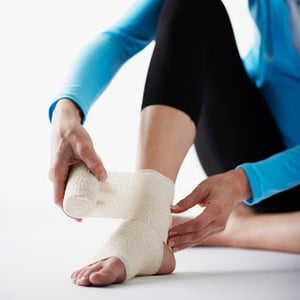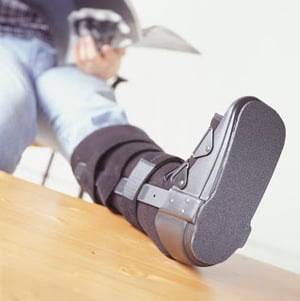26 bones. 33 joints. Over 100 ligaments and muscles. There are a lot of pieces and parts to our feet. It's no wonder foot and ankle injuries are one of the most common things that cause a visit to the orthopedic doctor.
Feet aren't just complicated, they are hard working. Standing, walking, running, jumping... Your feet bear your entire body weight all day long. When something is hurt in your foot, it can cause problems throughout your body. If you think you have a foot injury, it's best to see a doctor before it turns into a more serious issue. Let's learn about common foot injuries and ways to avoid them.

Ankle sprains, strains & fractures
Strains happen when a muscle or tendon is overstretched. Sprains are a very common ankle injury that occurs to the ligaments. They are more serious than strains and are also caused by overstretching. According to the American College of Sports Medicine, 25,000 Americans suffer from an ankle sprain each day.
Symptoms
- Pain or tenderness in the area of the injury
- Swelling of the ankle

- Redness
- Bruising in the injured area, which may occur immediately or several hours following the injury
- Loss of mobility or difficulty walking
- Intense, shooting pain may indicate a break or a fracture
Common causes
- Stepping wrong on uneven ground
- Having your foot stepped on while in motion
- Landing incorrectly after jumping
- Jumping in an unbalanced position
- Obesity
How to avoid the injury
- Maintain physical fitness
- Maintain a healthy weight and diet
- Wear proper footwear and other protective gear for your sport or activity
- Strengthen weak muscles through exercise
Stress Fractures
Stress fractures are a type of overuse injury that cause tiny cracks in your bones. Stress fractures also can occur with normal usage if osteoporosis or some other disease weakens your bones and leaves them vulnerable. Most stress fractures occur in the weight-bearing bones of the foot and lower leg. The most commonly affected site is the second or third of the long bones (metatarsals) between the toes and the midfoot. Stress fractures are also commonly seen in the heel, the outer bone of the lower leg (fibula) and the bone on the top of the midfoot.
Symptoms
- Pain that develops slowly, increases with weight-bearing and decreases with rest
- Swelling near the injury
- Tenderness to the touch
Common Causes
- Doing too much physical activity too soon
- Improper equipment - such as shoes that are too stiff or don't provide enough support
- Weak bones caused by conditions such as osteoporosis
How to avoid the injury
- Start exercise gradually after time off. New to exercise? Talk to a certified trainer or your doctor about a program that includes gradual increases in training.
- Be fitted for the right shoes. Go to a local running store - even if you're not a runner - to get good shoes that will give your feet plenty of support.
Plantar Fasciitis
The Plantar Fascia is a broad, thick band of tissue that runs from under the heel to the front of the foot. Through overuse the fascia can become inflamed, slightly torn and painful - especially where it attaches to the heel bone.
Symptoms 
- Pain under the heel which may radiate into the foot
- Tenderness under and on the inside of the heel
- Pain is usually worse first thing in the morning but eases as the foot warms up only to return later in the day or after exercise
- Stretching the foot may be painful
Common causes
- Runners who overpronate (feet roll in ) or whose feet flatten too much are at risk becasue the plantar fascia is over stretched as the foot flattens.
- People with high arches are at risk because the foot is unable to absorb shock and adapt to the surface.
- Tight calf muscles which can cause overpronation and prevent the foot from adequately absorbing shock.
- Improper or poorly fitted shoes.
- Overweight individuals are more at risk of developing plantar fasciitis due to excess weight impacting on the foot.
How to avoid the injury
- Make sure you have the right shoes for your sport or exercise program
- Gradually increase your running distance or exercise program
Think you have a foot injury?
RICE: Rest. Ice. Compression. Elevation. Are all good ways to treat a suspected injury. However, if the pain lingers, it's time to see a doctor for accurate diagnosis and a rehabilitation plan. The orthopedics team at Logansport Memorial Hospital is ready to help with accessible, comprehensive care focused on getting you active again.




